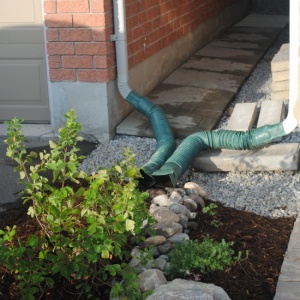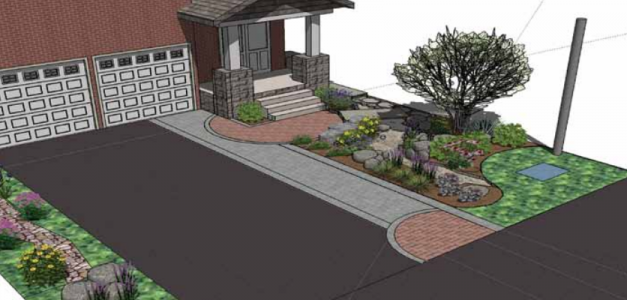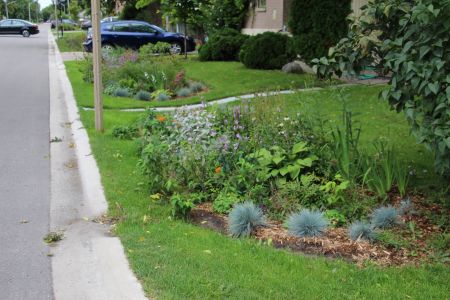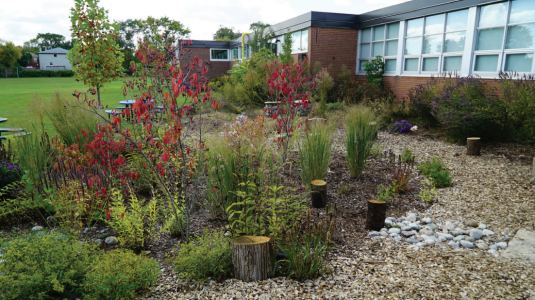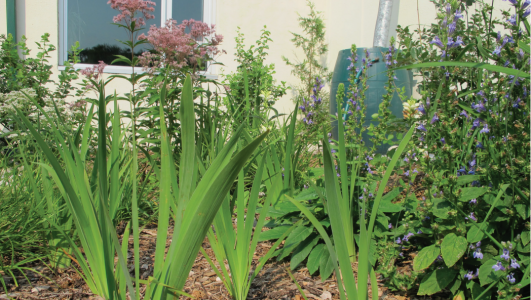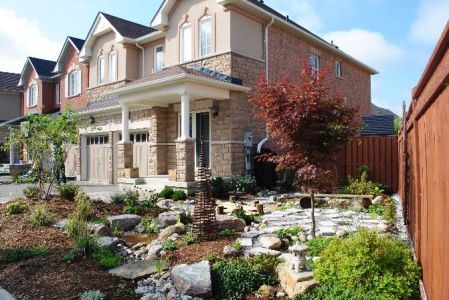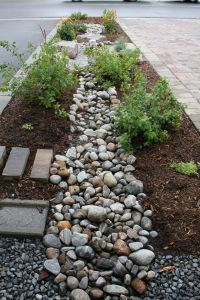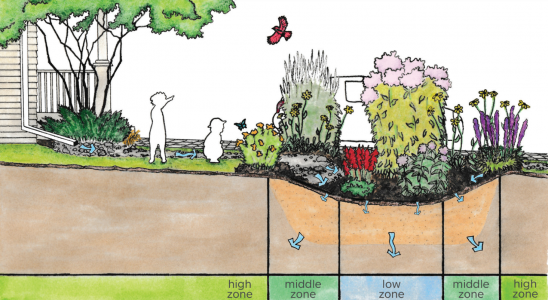Difference between revisions of "Rain gardens"
Dean Young (talk | contribs) |
|||
| (5 intermediate revisions by 2 users not shown) | |||
| Line 41: | Line 41: | ||
A well-designed rain garden can be maintained with minimal care, which is a great marketing point for persuading homeowners. In the first two years, the plants will need watering to ensure they become established. After this establishment period, the garden should only need simple maintenance, e.g. weeding. | A well-designed rain garden can be maintained with minimal care, which is a great marketing point for persuading homeowners. In the first two years, the plants will need watering to ensure they become established. After this establishment period, the garden should only need simple maintenance, e.g. weeding. | ||
| − | + | For a table summarizing information on planning considerations and site constraints see [[Site considerations]]. | |
| − | For | ||
==Design== | ==Design== | ||
| Line 73: | Line 72: | ||
|- | |- | ||
! Mid Zone | ! Mid Zone | ||
| − | | Often referred to as the | + | | Often referred to as the flood fringe area. This zone is inundated less frequently (2 – 100 year storm events) and has periodically high levels of moisture in the soil. The ecology of this zone is a transition from the Mineral Meadow Marsh/Beach-type community to an upland community. |
|- | |- | ||
! High Zone | ! High Zone | ||
| Often referred to as upland area. The ecology of this zone is terrestrial due to its elevation in relation to the filter bed. The zone most closely resembles a Cultural Meadow or a Cultural Thicket community, depending on the mix of grasses, herbaceous material, shrubs and trees utilized. | | Often referred to as upland area. The ecology of this zone is terrestrial due to its elevation in relation to the filter bed. The zone most closely resembles a Cultural Meadow or a Cultural Thicket community, depending on the mix of grasses, herbaceous material, shrubs and trees utilized. | ||
|} | |} | ||
| − | + | [[File:Soil moisture zones levels.PNG|600px|thumb|A simplified schematic depicting the three primary zones associated with soil moisture levels and the appropriate plant species selected for each zone's specific soil characteristics, best adapted to the area's growing conditions. ([https://cvc.ca/wp-content/uploads/2022/03/com_lo_rain-ready-guide_20220328-FINAL3.pdf|Photo Source: CVC, 2022])<ref>CVC. 2022. Native Plants for Rain-ready Landscapes> plant these native wildflowers, grasses, shrubs and groundcovers to help manage stormwater - beautifully. cvc.ca/GreenYourProperty. https://cvc.ca/wp-content/uploads/2022/03/com_lo_rain-ready-guide_20220328-FINAL3.pdf</ref>]] | |
'''Low Zone''' | '''Low Zone''' | ||
*Mineral Meadow Marsh plant community | *Mineral Meadow Marsh plant community | ||
| Line 102: | Line 101: | ||
*Smooth out any sharp corners to create flow in your garden. | *Smooth out any sharp corners to create flow in your garden. | ||
*Neat edges can be established using pavers, walls or bands of turf create an attractive amenity within the residential landscape. | *Neat edges can be established using pavers, walls or bands of turf create an attractive amenity within the residential landscape. | ||
| + | <br> | ||
| + | For adoption on residential properties see TRCA's [https://trca.ca/news/complete-guide-building-maintaining-rain-garden/ '''A Complete Guide to Maintaining a Rain Garden'''] | ||
==See Also== | ==See Also== | ||
| Line 111: | Line 112: | ||
*[http://www.raingardentour.ca/ Raingarden tour] | *[http://www.raingardentour.ca/ Raingarden tour] | ||
*[https://rainscapeto.ca/ RainScapeTO] | *[https://rainscapeto.ca/ RainScapeTO] | ||
| + | |||
| + | ==Gallery== | ||
| + | {{:Rain gardens: Gallery}} | ||
| + | |||
| + | ==References== | ||
[[category:infiltration]] | [[category:infiltration]] | ||
| − | |||
| − | |||
Latest revision as of 20:00, 6 October 2022
This article is about planted installations designed to capture surface runoff in an amended soil.
For more highly engineered systems, see Bioretention.
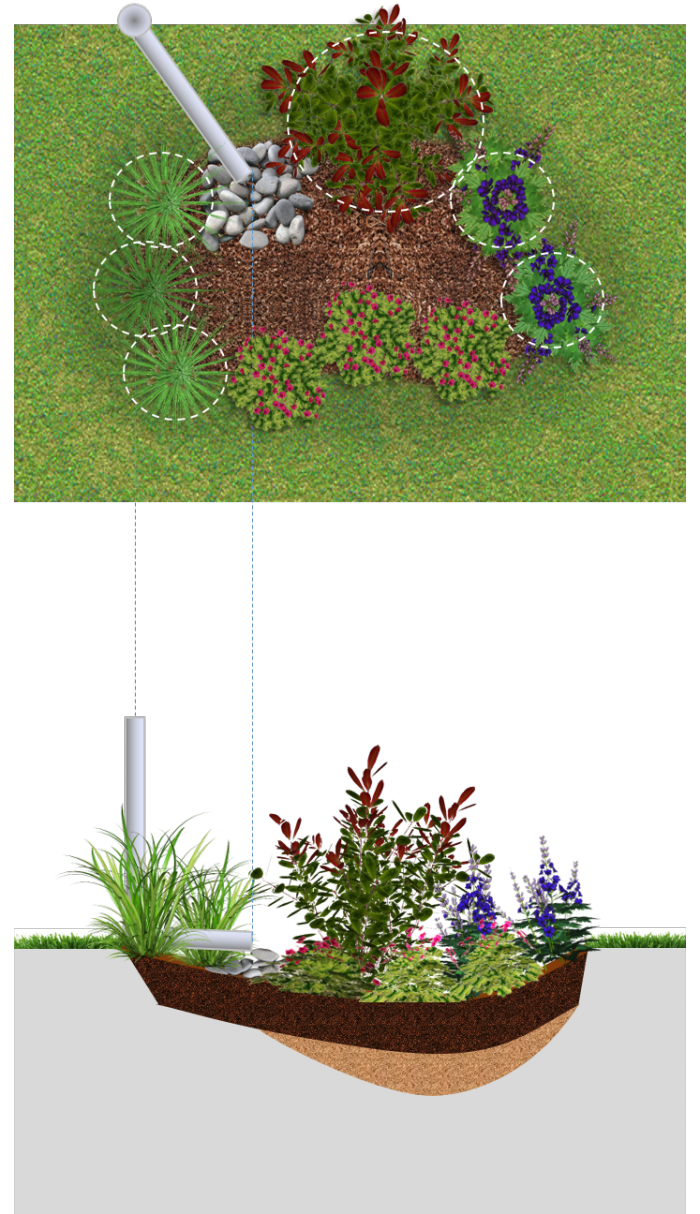
Overview[edit]
Rain gardens capture roof, lawn and driveway runoff from low to medium density residential lots. These can be simple gardens constructed by the homeowner as a retrofit, or they can be professionally designed into a residential development.
Rain gardens are ideal for:
- Capturing the flow from disconnected downspouts
- Community design/build projects for raising awareness about stormwater capture and functional landscapes
The fundamental components of a rain garden are:
- An amended soil mix
- Suitable planting
Additional components may include:
- A splash pad of stone to prevent the downspout flow from eroding the soil
- A simple overflow swale to another area of the garden
Planning Considerations[edit]
Raingardens look like typical gardens. However, their infiltration and bioretention functions are much greater than normal gardens. By landscaping areas to include a surface depression of approximately 150 mm, rain gardens allow runoff from residential properties to collect and to easily absorb into the ground. Within the rain garden, special types of soil, 'filter media' or soil amendments increase the amount of water absorbed by the garden and infiltrated into native soils.
Location is very important to a functioning rain garden. When looking at potential locations, look for low areas where runoff can be easily be directed into the garden. Rain gardens are a great option for residential LID retrofits because homeowners can customize the garden to suit their desired styles. They can be planted with a variety of vegetation including shrubs, grasses and flowers.
A well-designed rain garden can be maintained with minimal care, which is a great marketing point for persuading homeowners. In the first two years, the plants will need watering to ensure they become established. After this establishment period, the garden should only need simple maintenance, e.g. weeding.
For a table summarizing information on planning considerations and site constraints see Site considerations.
Design[edit]
Plant Selection[edit]
The design of a rain garden allows for several different planting zones.
- A variety of plant material can be selected based on the desired aesthetic, including turf grass, ornamental grasses and perennial flowers, shrubs, and trees.
- The aesthetic can range from very naturalistic to quite formal, depending on the planting plan.
- Vegetation must also be capable of tolerating prolonged wet and dry periods unless an irrigation plan is in place
- If the facility is intended to be relatively inconspicuous, then the tallest plant material should be placed into the deepest part of the rain garden. Otherwise, choose taller plants for the back of the garden tapering the height down to the front of the garden. [1].
Since rain gardens are typically smaller scale homeowner projects smaller stock plants may be considered. Smaller containers may be easier to purchase, transport, and plant, but it may take longer to have a fully vegetated garden. Plant material per Canadian Standards for Nursery Stock, Eighth Edition. Seed planting is not recommended for rain gardens. Plants should be container grown, balled and burlapped or wire basket.
Below are recommended plant sizes for planting rain garden features:
Deciduous Shrubs - 60 - 80 cm height
Coniferous Shrubs / Broadleaf Evergreens - 40 cm spread (roughly #3 or 3 gal. container)
Perennials/Grasses - 15 cm to #1 or 1 gal. container stock
Ground Cover/ Vines - 10 cm to #1 or 1 gal. container stock
Hydric Zone Criteria[edit]
| Low Zone | Often referred to as the extended detention or shoreline fringe area. This area is frequently inundated during storm events, and is well-drained between rainfall events. |
|---|---|
| Mid Zone | Often referred to as the flood fringe area. This zone is inundated less frequently (2 – 100 year storm events) and has periodically high levels of moisture in the soil. The ecology of this zone is a transition from the Mineral Meadow Marsh/Beach-type community to an upland community. |
| High Zone | Often referred to as upland area. The ecology of this zone is terrestrial due to its elevation in relation to the filter bed. The zone most closely resembles a Cultural Meadow or a Cultural Thicket community, depending on the mix of grasses, herbaceous material, shrubs and trees utilized. |
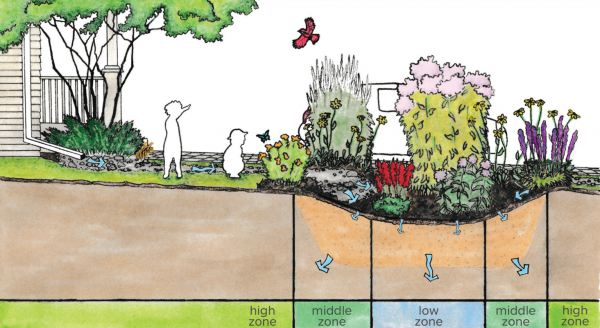
Low Zone
- Mineral Meadow Marsh plant community
- Grasses, Sedges, rushes, wildflowers, ferns and shrubs that have an ‘Obligate’ to ‘Facultative’ designation
- Wetland ‘Obligate’ species that are flood tolerant as they will persist in average years and flourish in wetter years.
- Plants that are likely to occur in wetlands or adjacent to wetlands.
- Plants with dense root structure and /or vegetative cover are favoured for their ability to act as pollution filters and tendency to slow water velocity
- Be advised these practices are not constructed wetlands and are designed to fully drain within 48 hours.
Mid Zone
- Plants able to survive in soils that are seasonally saturated, yet can also tolerate periodic drought.
- Species include grasses and groundcovers, as well as low shrub species.
High Zone
- Plants should have deep roots for structure, be drought-tolerant and capable of withstanding occasional soil saturation.
- Trees and large shrubs planted in this zone will aid in the infiltration and absorption of stormwater.
- This area can be considered a transition area into other landscape or site areas.
- A variety (min. five) species should be used to prevent a monoculture.
Landscaping Design Consideration[edit]
- In natural areas, a diversity of plant types not only adds beauty but also create a thick underground root matrix that keeps the entire plant community in balance. In fact, 80% of the plant mass in native prairie communities is underground. Once the rain garden has matured and your sedges, rushes and grasses have established a deep, thick root system, there will be less change in species location from year to year, and weeds will naturally decline. [3].
- Smooth out any sharp corners to create flow in your garden.
- Neat edges can be established using pavers, walls or bands of turf create an attractive amenity within the residential landscape.
For adoption on residential properties see TRCA's A Complete Guide to Maintaining a Rain Garden
See Also[edit]
External Links[edit]
Gallery[edit]
Lake Wilcox Snap project that installed Rain garden features along with bioswales, rainwater harvesting barrels and Permeable pavement parking lots of residents. Read more about the retrofits, their performance and the overall project in the, Lake Wilcox SNAP Embracing Nature in the Community. Photo credit: CVC, 2016.
Rain Gardens located on private, lot-level properties in the Lakeview Neighborhood in Mississauga, ON. Read more about the project here, in the Lakeview Village Sustainability Strategy DRAFT.
Typical close up of a rain garden and some of the plants located in the low hydric zone. This low zone is often referred to as the extended detention or shoreline fringe area. This area is frequently inundated during storm events, and is well-drained between rainfall events. CVC, 2022.
An example of a finished house with multiple LID practices installed within the Lake Wilcox Snap project site. Read more about the neighbourhood in the, Lake Wilcox SNAP Embracing Nature in the Community. Photo credit: CVC, 2016.
A simplified schematic depicting the three primary zones associated with soil moisture levels and the appropriate plant species selected for each zone's specific soil characteristics, best adapted to the area's growing conditions. (Source: CVC, 2022)[4]
References[edit]
- ↑ Peel Fusion Landscaping
- ↑ CVC. 2022. Native Plants for Rain-ready Landscapes> plant these native wildflowers, grasses, shrubs and groundcovers to help manage stormwater - beautifully. cvc.ca/GreenYourProperty. https://cvc.ca/wp-content/uploads/2022/03/com_lo_rain-ready-guide_20220328-FINAL3.pdf
- ↑ Appendix D - Low Impact Development Concepts, Rain Gardens: A how-to manual for homeowners, Wisconsin Department of Natural Resources, Page 15
- ↑ CVC. 2022. Native Plants for Rain-ready Landscapes> plant these native wildflowers, grasses, shrubs and groundcovers to help manage stormwater - beautifully. cvc.ca/GreenYourProperty. https://cvc.ca/wp-content/uploads/2022/03/com_lo_rain-ready-guide_20220328-FINAL3.pdf
